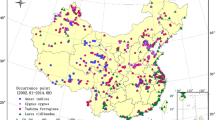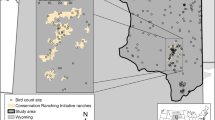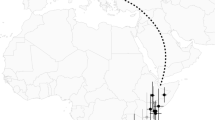Abstract
Advanced satellite tracking technologies provide biologists with long-term location sequence data to understand movement of wild birds then to find explicit correlation between dynamics of migratory birds and the spread of avian influenza. In this paper, we propose a hierarchical clustering algorithm based on a recursive grid partition and kernel density estimation (KDE) to hierarchically identify wild bird habitats with different densities. We hierarchically cluster the GPS data by taking into account the following observations: 1) the habitat variation on a variety of geospatial scales; 2) the spatial variation of the activity patterns of birds in different stages of the migration cycle. In addition, we measure the site fidelity of wild birds based on clustering. To assess effectiveness, we have evaluated our system using a large-scale GPS dataset collected from 59 birds over three years. As a result, our approach can identify the hierarchical habitats and distribution of wild birds more efficiently than several commonly used algorithms such as DBSCAN and DENCLUE.
Similar content being viewed by others
Explore related subjects
Discover the latest articles and news from researchers in related subjects, suggested using machine learning.References
Chen H, Li Y, Li Z, Shi J, Shinya K, Deng G, Qi Q, Tian G, Fan S, Zhao H, Sun Y X, Kawaoka Y. Properties and dissemination of H5N1 viruses isolated during an influenza outbreak in migratory waterfowl in western China. Journal of Virology, 2006, 80(12): 5976–5983
Liu J, Xiao H, Lei F, Zhu Q, Qin K, Zhang X W, Zhang X L, Zhao D, Wang G, Feng Y, Ma J, Liu W, Wang J, Gao G F. Highly pathogenic H5N1 influenza virus infection in migratory birds. Science, 2005, 309(5738): 1206
Wilcove D S. No way home: the decline of the world’s great animal migrations. Island Press, 2007
Chen C, Rinsurongkawong V, Eick C, Twa M. Change analysis in spatial data by combining contouring algorithms with supervised density functions. Advances in Knowledge Discovery and Data Mining, 2009, 907–914
Jenson S, Domingue J. Extracting topographic structure from digital elevation data for geographic information system analysis. Photogrammetric Engineering and Remote Sensing, 1988, 54(11): 1593–1600
Wang W, Yang J, Muntz R. Sting: a statistical information grid approach to spatial data mining. In: Proceedings of the 1997 International Conference on Very Large Data Bases. 1997, 186-195
Hinneburg A, Keim D A. An efficient approach to clustering in large multimedia databases with noise. Bibliothek der Universität Konstanz, 1998
Bowlin M S, Bisson I A, Shamoun-Baranes J, Reichard J D, Sapir N, Marra P P, Kunz T H, Wilcove D S, Hedenström A, Guglielmo C G, Akesson S, Ramenofsky M, Wikelski M. Grand challenges in migration biology. Integrative and Comparative Biology, 2010, 50(3): 261–279
Li Z, Ji M, Lee J G, Tang L A, Yu Y, Han J, Kays R. MoveMine: mining moving object databases. In: Proceedings of the 2010 International Conference on Management of Data. 2010, 1203–1206
Li Z, Han J, Ji M, Tang L A, Yu Y, Ding B, Lee J G, Kays R. MoveMine: mining moving object data for discovery of animal movement patterns. ACM Transactions on Intelligent Systems and Technology (TIST), 2011, 2(4): 37
Bar-David S, Bar-David I, Cross P C, Ryan S J, Knechtel C U, Getz W M. Methods for assessing movement path recursion with application to African buffalo in South Africa. Ecology, 2009, 90(9): 2467–2479
Cañizo Rincon J, Carrillo J, Rosado J. Collective behavior of animals: swarming and complex patterns. Arbor: Ciencia, Pensamiento y Cultura, 2010 (746): 1035–1049
Li Z, Ding B, Han J, Kays R. Swarm: mining relaxed temporal moving object clusters. Proceedings of the VLDB Endowment, 2010, 3(1–2): 723–734
Altizer S, Bartel R, Han B A. Animal migration and infectious disease risk. Science, 2011, 331(6015): 296–302
Si Y, Skidmore A, Wang T, Boerd W, Debba P, Toxopeus A, Li L, Prins H. Spatio-temporal dynamics of global H5N1 outbreaks match bird migration patterns. Geospatial Health, 2009, 4(1): 65–78
Takekawa J Y, Newman S H, Xiao X, Prosser D J, Spragens K A, Palm E C, Yan B, Li T, Lei F, Zhao D, Douglas D C, Muzaffar S B, Ji W. Migration of waterfowl in the east Asian flyway and spatial relationship to HPAI H5N1 outbreaks. Avian Diseases, 2010, 54 (s1): 466–476
Shimazaki H, Tamura M, Higuchi H. Migration routes and important stopover sites of endangered oriental white storks (ciconia boyciana) as revealed by satellite tracking. Memoirs of the National Institute of Polar Research Special, 2004, (58): 162–178
Ester M, Kriegel H P, Sander J, Xu X. A density-based algorithm for discovering clusters in large spatial databases with noise. In: Proceedings of the 2nd International Conference on Knowledge Discovery and Data Mining. 1996, 226–231
Tang M, Zhou Y, Li J, Wang W, Cui P, Hou Y, Luo Z, Li J, Lei F, Yan B. Exploring the wild birds’ migration data for the disease spread study of H5N1: a clustering and association approach. Knowledge and Information Systems, 2011, 27(2): 227–251
Ankerst M, Breunig M M, Kriegel H P, Sander J. Optics: ordering points to identify the clustering structure. ACM SIGMOD Record, 1999, 28(2): 49–60
Worton B J. Kernel methods for estimating the utilization distribution in home-range studies. Ecology, 1989, 70(1): 164–168
Prosser D J, Cui P, Takekawa J Y, Tang M, Hou Y, Collins B M, Yan B, Hill N J, Li T, Li Y, Lei F, Guo S, Xing Z, He Y, Zhou Y, Douglas D C, Perry W M, Newman S H. Wild bird migration across the Qinghai-Tibetan Plateau: a transmission route for highly pathogenic H5N1. PloS One, 2011, 6(3): e17622
Cui P, Hou Y, Tang M, Zhang H, Zhou Y, Yin Z, Li T, Guo S, Xing Z, He Y, Prosser D J, Newman S H, Takekawa J Y, Yan B, Lei F. Movement patterns of bar-headed geese anser indicus during breeding and post-breeding periods at Qinghai Lake, China. Journal of Ornithology, 2011, 152(1): 83–92
Maciejewski R, Rudolph S, Hafen R, Abusalah A, Yakout M, Ouzzani M, Cleveland WS, Grannis S J, Ebert D S. A visual analytics approach to understanding spatiotemporal hotspots. IEEE Transactions on Visualization and Computer Graphics, 2010, 16(2): 205–220
Xie C, Song Y, Liu Z. Density-based clustering algorithm using kernel density estimation and hill-down strategy. Journal of Information and Computational Science, 2010, 7(1): 135–142
Kulczycki P, Charytanowicz M, Kowalski P A, Lukasik S. The complete gradient clustering algorithm: properties in practical applications. Journal of Applied Statistics, 2012, 39(6): 1211–1224
Cui P, Hou Y, Xing Z, He Y, Li T, Guo S, Luo Z, Yan B, Yin Z, Lei F. Bird migration and risk for H5N1 transmission into Qinghai Lake, China. Vector-Borne and Zoonotic Diseases, 2011, 11(5): 567–576
Prosser D J, Takekawa J Y, Newman S H, Yan B, Douglas D C, Hou Y, Xing Z, Zhang D, Li T, Li Y, Zhao D, Perry W M, Palm E C. Satellitemarked waterfowl reveal migratory connection between H5N1 outbreak areas in China and Mongolia. Ibis, 2009, 151(3): 568–576
Seaman D E, Powell R A. An evaluation of the accuracy of kernel density estimators for home range analysis. Ecology, 1996, 2075–2085
Muzaffar S B, Takekawa J Y, Prosser D J, Douglas D C, Yan B, Xing Z, Hou Y, Palm E C, Newman S H. Seasonal movements and migration of Pallas’s Gulls Larus ichthyaetus from Qinghai Lake, China. Forktail, 2008, 24: 100–107
Author information
Authors and Affiliations
Corresponding author
Additional information
Yuwei Wang is a PhD candidate in University of Chinese Academy of Sciences. His research activities are focused on visual analytics and visual data mining. He is currently working on analysis and visualization of animal migration, and e-Science applications.
Yuanchun Zhou is an associate professor in the Computer Network Information Center, Chinese Academy of Sciences. He received his PhD from the Institute of Computing Technology, Chinese Academy of Sciences, in 2006. His main research interests include data mining, and data intensive computing. He has published over 50 papers in international journals and conferences.
Ying Liu received her BS from Peking University, China, in 1999, and her MS and PhD from Northwestern University, Evanston, IL, USA, in Computer Engineering in 2001 and 2005, respectively. She is currently an associate professor in University of Chinese Academy of Sciences, where she also holds an adjunct appointment with Fictitious Economy and Data Science Research Center of Chinese Academy of Sciences. Her research interests include data mining, high-performance computing, and business intelligence.
Ze Luo is an associate professor in the Computer Network Information Center, Chinese Academy of Sciences. He received his PhD from the Institute of Computing Technology, Chinese Academy of Sciences, in 2005. His interests include scientific computing grid, e-Science, and data mining.
Danhuai Guo is an associate professor in the Computer Network Information Center, Chinese Academy of Sciences. He received his PhD from the Institute of Remote Sensing and Applications, Chinese Academy of Sciences, in 2009. His main research interests include spatio-temporal data mining, spatial and temporal Analysis, GIS and public health, and high performance GIS. He has published more than 20 peer reviewed papers in international journals and conferences. Jing Shao received his MS in Computer Science from the Graduate University of Chinese Academy of Sciences. His research activities are focused on data mining and machine learning. He is currently working on species distribution modeling and e-Science applications.
Fei Tan is a graduate student in Graduate University of Chinese Academy of Sciences. His research interests lie primarily in data mining, and NLP and related applications. He is currently using data mining to discover patterns in ecological data.
Liang Wu received his BS from the School of Software Engineering, Beijing University of Posts and Telecommunications in 2011. He is a master’s student in the Computer Network Information Center, Chinese Academy of Sciences. His research interests include text mining and trajectory mining.
Jianhui Li is a professor in the Computer Network Information Center, Chinese Academy of Sciences. He received his PhD from the Institute of Computing Technology, Chinese Academy of Sciences in 2007. His main research interests include large-scale distributed databases management and integration, semantic-based data integration, and data intensive computing and scientific applications.
Baoping Yan is a professor and chief engineer in the Computer Network Information Center, Chinese Academy of Sciences. Prior to this, she served as vice president of Dawning Information Industry. She has completed analysis and design of computer network systems, research and implementation of industrial automation and CIMS network technology, ATM-based workstation cluster systems, standard management of large-scale networks and system integration, Internet/Intranet comprehensive information management systems, etc. Currently, she is responsible for the planning and construction of the informatization of the Chinese Academy of Sciences during the 10th Five-year Plan period. She has published more than 50 research papers at home and abroad. The government has granted her special allowance for her outstanding contributions.
Rights and permissions
About this article
Cite this article
Wang, Y., Zhou, Y., Liu, Y. et al. A grid-based clustering algorithm for wild bird distribution. Front. Comput. Sci. 7, 475–485 (2013). https://doi.org/10.1007/s11704-013-2223-2
Received:
Accepted:
Published:
Issue Date:
DOI: https://doi.org/10.1007/s11704-013-2223-2




